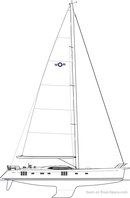Oyster 825 Standard
Sailboat specifications
The Oyster 825 is a 79’2” (24.14m) cruising sailboat designed by Humphreys Yacht Design (United Kingdom). She was built between 2014 and 2017 by Oyster (United Kingdom).
The Oyster 825 is as well listed, on Boat-Specs.com, in Shoal draft version (see all the versions compared).
The Oyster 825 is as well listed, on Boat-Specs.com, in Shoal draft version (see all the versions compared).
Oyster 825's main features
- Model
- Oyster 825
- Version
- Standard
- Hull type
- Monohull
- Category
- Offshore cruising sailboat
- Sailboat builder
- Sailboat designer
- Country
- United Kingdom
- Construction
- Hull and deck: GRP (glass reinforced polyester)
- First built hull
- 2014
- Last built hull
- 2017
- Appendages
- Keel : L-shaped keel (with bulb)
- Helm
- Twin helm wheels
- Rudder
- Twin spade rudders
- Unsinkable
- No
- Trailerable
- No
- EC design categoryiThe CE design category indicates the ability to cope with certain weather conditions (the sailboat is designed for these conditions)
A: Wind < force 9, Waves < 10m
B: Wind < force 8, Waves < 8m
C: Wind < force 6, Waves < 4m
D: Wind < force 4, Waves < 0,5m - A
- Standard public price ex. VAT (indicative only)
- About6 700 000 €(2016)
Oyster 825's main dimensions
- Overall length
- 82’ 6”25.15 m
- Hull length
- 79’ 2”24.14 m
- Waterline length
- 72’ 1”21.97 m
- Beam (width)
- 20’ 8”6.31 m
- Draft
- 11’ 2”3.42 m
- Mast height from DWL
- 112’ 1”34.16 m
- Light displacement (MLC)
- 123459 lb56000 kg
Oyster 825's rig and sails
- Upwind sail area
- 3439 ft²319.5 m²
- Rigging type
- Sloop Marconi 19/20
- Mast configuration
- Keel stepped mast
- Rotating spars
- No
- Number of levels of spreaders
- 3
- Spreaders angle
- Swept-back
- Spars construction
- Aluminum spars
Oyster 825's performances
- Upwind sail area to displacementiThe ratio sail area to displacement is obtained by dividing the sail area by the boat's displaced volume to the power two-thirds.
The ratio sail area to displacement can be used to compare the relative sail plan of different sailboats no matter what their size.
Upwind: under 18 the ratio indicates a cruise oriented sailboat with limited performances especially in light wind, while over 25 it indicates a fast sailboat. - 235 ft²/T21.83 m²/T
- Displacement-length ratio (DLR)iThe Displacement Length Ratio (DLR) is a figure that points out the boat's weight compared to its waterline length. The DLR is obtained by dividing the boat's displacement in tons by the cube of one one-hundredth of the waterline length (in feet).
The DLR can be used to compare the relative mass of different sailboats no matter what their length:
a DLR less than 180 is indicative of a really light sailboat (race boat made for planning), while a DLR greater than 300 is indicative of a heavy cruising sailboat. - 150
- Critical hull speediAs a ship moves in the water, it creates standing waves that oppose its movement. This effect increases dramatically the resistance when the boat reaches a speed-length ratio (speed-length ratio is the ratio between the speed in knots and the square root of the waterline length in feet) of about 1.2 (corresponding to a Froude Number of 0.35) . This very sharp rise in resistance, between speed-length ratio of 1.2 to 1.5, is insurmountable for heavy sailboats and so becomes an apparent barrier. This leads to the concept of "hull speed".
The hull speed is obtained by multiplying the square root of the waterline length (in feet) by 1.34. - 11.38 knots
Oyster 825's auxiliary engine
- Engine(s)
- 1 inboard engine
- Engine(s) power
- 305 HP
- Fuel type
- Diesel
- Fuel tank capacity
- 792.5 gal3000 liters
Oyster 825's accommodations and layout
- Cockpit
- Center cockpit
- Cabin(s) (min./max.)
- 4 / 5
- Berth(s) (min./max.)
- 8 / 10
- Head(s) (min./max.)
- 4 / 5
- Freshwater tank capacity
- 528.3 gal2000 liters

















Oyster 825 interior and accommodations - - 16/24
Picture extracted from the commercial documentation © Oyster
Picture extracted from the commercial documentation © Oyster


Oyster 825 interior and accommodations - - 17/24
Picture extracted from the commercial documentation © Oyster
Picture extracted from the commercial documentation © Oyster


Oyster 825 interior and accommodations - - 18/24
Picture extracted from the commercial documentation © Oyster
Picture extracted from the commercial documentation © Oyster


Oyster 825 interior and accommodations - - 19/24
Picture extracted from the commercial documentation © Oyster
Picture extracted from the commercial documentation © Oyster


Oyster 825 interior and accommodations - - 20/24
Picture extracted from the commercial documentation © Oyster
Picture extracted from the commercial documentation © Oyster


Oyster 825 interior and accommodations - - 21/24
Picture extracted from the commercial documentation © Oyster
Picture extracted from the commercial documentation © Oyster


Oyster 825 interior and accommodations - - 22/24
Picture extracted from the commercial documentation © Oyster
Picture extracted from the commercial documentation © Oyster


Oyster 825 interior and accommodations - - 23/24
Picture extracted from the commercial documentation © Oyster
Picture extracted from the commercial documentation © Oyster

Similar sailboats that may interest you:
Sailboats
First built hull
Hull length
1988
52’ 6”16 m
2010
63’ 1”19.22 m
2014
64’ 1”19.55 m
2014
79’ 2”24.14 m
2001
72’21.95 m
2015
67’ 4”20.5 m
2011
62’ 5”19.03 m
2014
65’ 4”19.89 m
2014
71’ 8”21.86 m
2013
85’ 6”26.06 m
2017
50’ 11”15.51 m
2016
69’ 10”21.26 m
2012
71’ 6”21.8 m
2007
68’ 11”21.01 m
2018
85’ 6”26.06 m